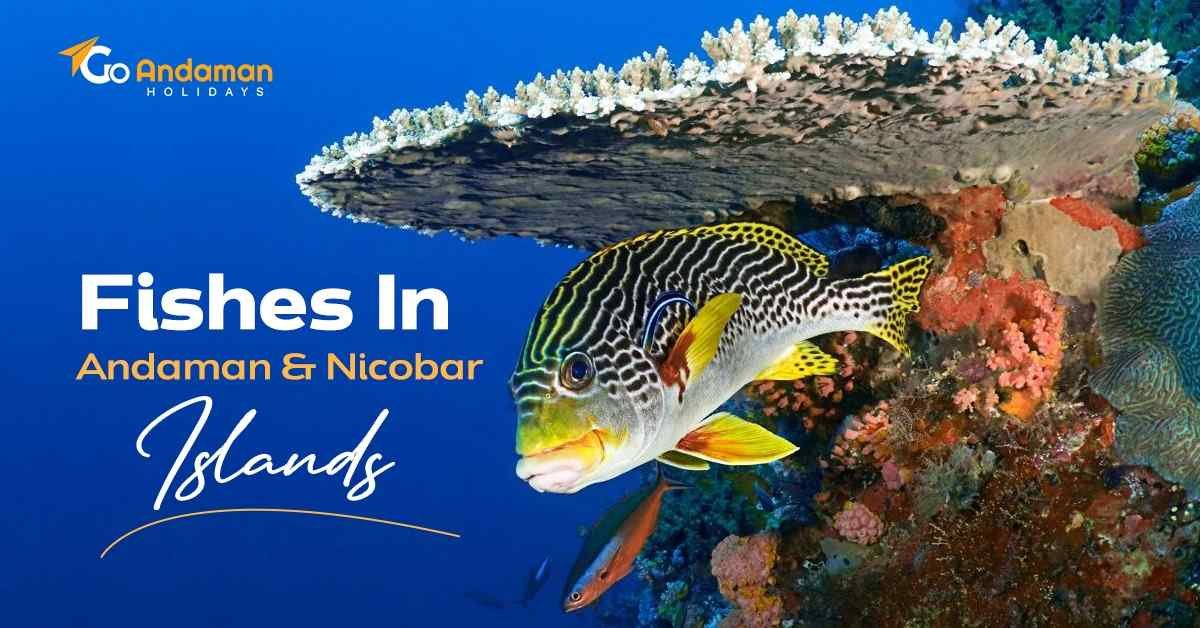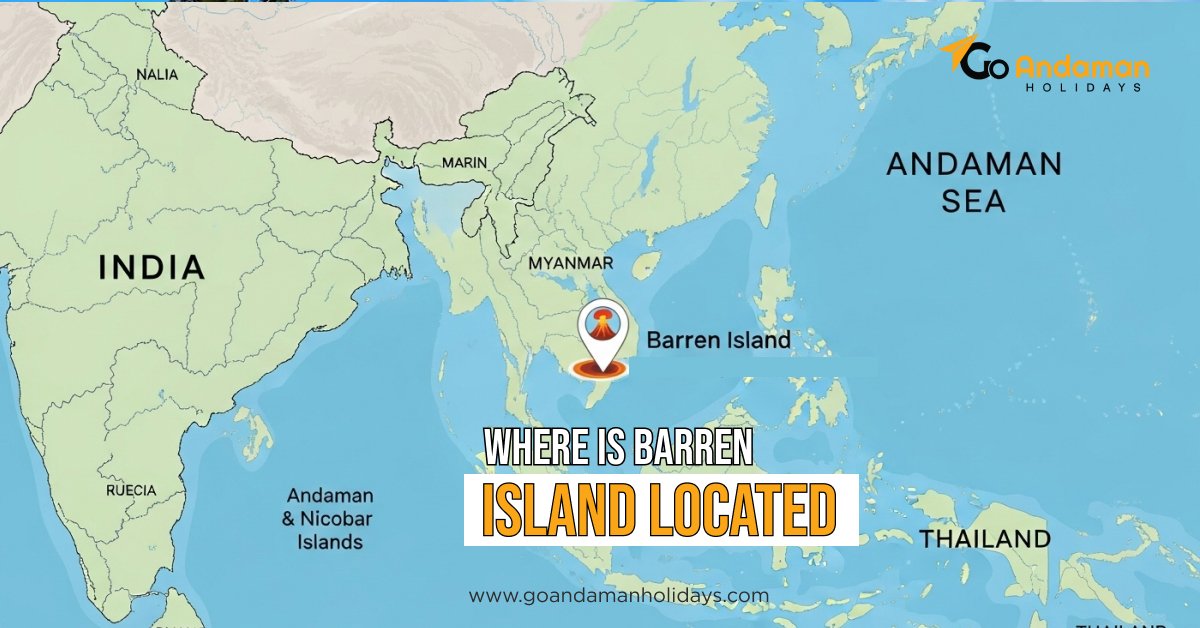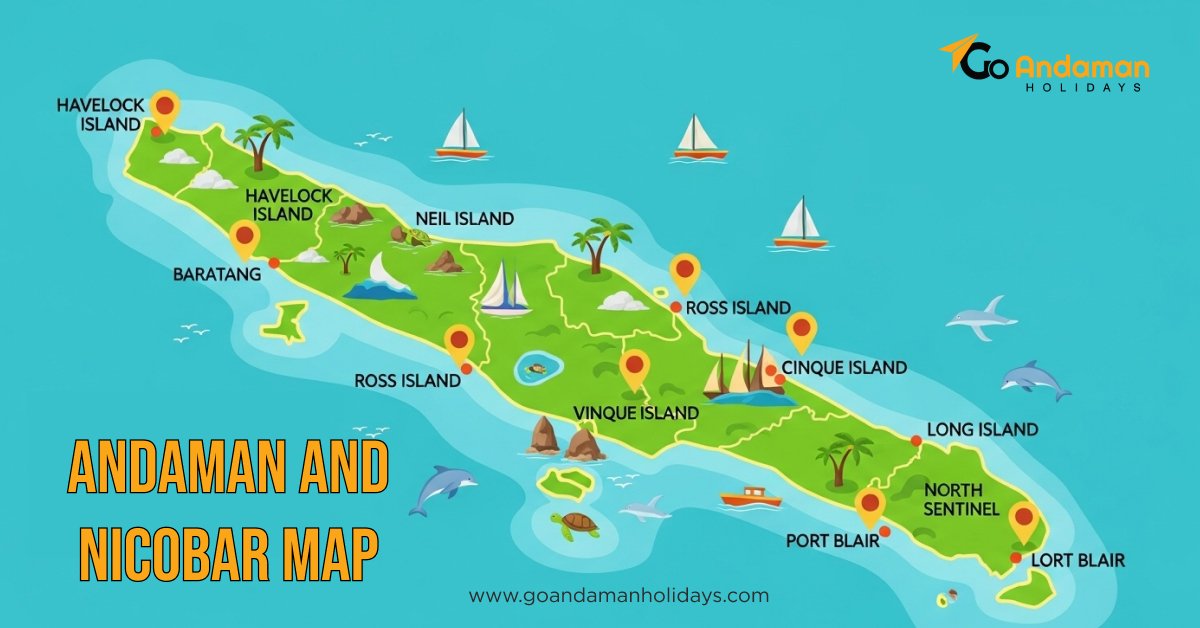
- Go Andaman Holiday
- 12-07-2024
- 1 Comments
Vibrant, Colourful and Unique Fishes of the Andaman and Nicobar Islands
Picture a beach at the Andaman and Nicobar Islands – crystal blue waters, sunlight, other colours and life forms under the sea.
It is not only about golden sand and the dense equatorial forests but vivid and extraordinary fish one can only encounter in this significant area.
Here we go, let’s get that mermaid suit on and explore this marvellous underwater world and get to know a few colourful inhabitants!
Fishes in Andaman and Nicobar Islands
If there is one place that boats incredible fish species, it has to be the waters surrounding the Andaman and Nicobar Islands.
So, to get an idea of who or what it is we are up against, let us meet a few of these flamboyant and colourful species starting with the Giant Trevally to the speedster Wahoo to know why these waters are so special.
1. Clownfish: The Celebrities of the Sea
Often the Oscars and the Lucky Stars have been awarded to ocean celebrities.
Remember Nemo?
Well, the Andaman and Nicobar Islands are blessed with the pin-up, animated fish movie, the clownfish, which you can often see prancing around sea anemones.
These cutie pies which are little orange and white striped pop celebrities are not only charming eye candies but also interesting.
They coexist in a mutually beneficial manner with host anemones, with the latter giving the fish protection from predators, and, in return, the fish help clean the anemone.
This is the perfect marriage or strategic alliance that warms the cockles, as much as it is economic!
2. Parrotfish: The Underwater Artists
Up next, meet the parrotfish, the artists of the reef Diving down to the sea and the beautiful coral reefs, we stumble upon a colourful group of fish.
These brilliant-hued fish open their mouths and let out rows of beak-like teeth they use to munch through the coral and rock that form these sandy shores we all enjoy.
Adorable, stunning, colourful and with many bluish-tinged shades, Parrotfish also alter colours as they grow older. To witness them feeding on the algal surface is like watching a living rainbow of colours working.
3. Lionfish: The Majestic Yet Dangerous Beauties
The lionfish is what you can call ‘noble looking’ as the fish carries the attribute of a potential killer. These fish have gorgeous appendages that are elongated to be languid; they also have spectacular colours and trails that make them appear like kings of the seas.
However, they have venomous spines, making sure people still remember it can be dangerous to be overly beautiful. Although they prefer to defend themselves with spines they can move very smoothly through water and to observe them is impressive.
4. Butterflyfish: The Social Butterflies
Another aspect about butterflyfish is that they are sociology of the reef since they are often seen moving in groups of two to four. These fish have extremely elaborate spots and stunning bright colours with which they can easily be identified.
Because of camouflage and movements – The flat and discus form of their body enables them to move within and around the coral Lark.
5. Mandarinfish: The Jewels of the Reef
The Jewels that lie underneath the water surface of the reef are numerous.
Were there to be competition for the liveliest fish ever, then the mandarin fish would most unquestionably be amongst the most illustrious.
These are minute fish clad in a shade of blue, orange and green that appear as if it has been borrowed from a painter’s canvas. They are rather timid, favouring the shade of the larger coral formations and they blend in so well when they are seen, it seems like seeing a pearl.
6. Sweetlips: The Adorable Pout
Sweetlips might seem like an amusing name on the lexical level, but once you witness these fish with your own eyes, their name is quite self-explanatory. They have full, plump lips that remind one of one being shy, and always posing for a selfie.
Sweetlips in particular are available in different sorts of stripes and colours and although they might not seem as graceful as the other fish in the site, their bubbly disposition makes them quite endearing to the reef.
7. Surgeonfish: The Reef's Doctors
As the name surgeon suggests, they have sharp spines near the tail like tools used by doctors, surgeonfish are the doctors of the reef. This fish is physically seen in formation, in large groups, and feeds on algae most of the time.
The fish are lean and beautiful in their sleek streamlined forms that swish about them while they proudly glow with bright body colours as they go about their business of maintaining the health of the reef.
8. The Enigmatic Pipefish: Cousin of Seahorse
Seahorses have pipefish as their close relatives, only they are laid-back and sneaky. They are skinny with lots of limbs and heads and have elegant faces that are hard to distinguish when they are hiding.
Dwelling near some seagrass or branches of corals, pipefish can undoubtedly be considered something which has never been created by people but rather has emerged from the depth of the creators’ imagination.
9. Giant Trevally (KOKARI): The Ocean's Titan
Let’s welcome the most famous inhabitant of the waters – KOKARI, or Giant Trevally. This fish is the largest of the jack family, although certain specimens reach up to 200 pounds!
Capturing one is always great fun since they fight to the bitter end, which makes them preferred by fishermen. Seeing a Giant Trevally being reeled in is one of the most impressive tutorials one can witness.
10. Blue Fin Trevally (Neel KOKARI): The Fleet Predator
Locals also enjoy Blue Fin Trevally, also commonly called Neel KOKARI. It lives in schools and is quite the predator of a fish. Usually, these fish are seen schooling and they are quite the hunters.
These dogs which weigh between 10 and 40 pounds will enjoy a chase with bait and lure. They are available in the foreign market, which has led to the breeding of the fish and they are suitable for large tanks but require some time.
11. Coral Trout: The Reef's Chameleon
One of the fighters of the Coral reefs, Coral Trout is often referred to as Leopards of the Reef. These fish are somewhat sneaky and their amazingly coloured bodies help them blend in nicely with the coral formation which means they are easy prey for no one.
It changes colour through the day and they are very much a fighting fish, using all their body strength to try and get free.
12. Green Jobfish: The Emerald Hunter
Thus, by calling Green Jobfish not only fish of the snapper family but also predators, the given piece offers a playful insight into the creatures employees might encounter on their way to success.
This fish is used both for game fishing and for aquarium purposes as well. These fish species are also associated with their higher speed and incidence of fighting; thus, they always contribute to the staking of fishing.
13. Wahoo (KAW-WA SURMAI): The Speed Demon
The Wahoo or KAW-WA SURMAI is among some of the fish species that are said to swim with great speed in the waters. They weigh between 70 pounds and are known to swim occasionally for prey on water that is not deep.
They are pretty fast and most of them have powerful muscles so getting them as a catch is always good news but always brace yourself for a fight if you have been lucky to hook one.
14. Skipjack Tuna: The Tireless Swimmer
The compelling picture titled “The Tireless Swimmer” justifies the artist’s fame.
Skipjack Tuna is one of the tastes where people are willing to pay good money, and in addition, creativity helps to make them good to look at as well.
Osamobis fish have about three times the size of heart as their body size and these fish are very energetic to swim through large distances. These two species are known for their vigorous battles which makes them exhilarating catches in the fishing zones of the Andamans.
15. Barracuda (Dandus): The Underwater Missile
Belonging to the species Sphyraena bodparia or Indian Barracuda, also called Dundas locally, these fish can weigh over 45 kilograms and are known to be perilously temperamental and aggressive.
These cannot be domesticated in tanks but are sports fish to catch they jump high in deep waters and change colour. But alongside it, in the unspoiled waters of Andamans, these are equally delicious.
16. Dorado (HAATHI KOKARI): The Golden Jumper
The Dorado, also called HAATHI KOKARI or the common name Mahi Mahi or Dolphin Fish, is a preferred game fish. Both sexes are not difficult to distinguish—males consequently have bald foreheads.
These fish can be enormous, with some of them weighing as much as 80 pounds, and they are commercially valuable, especially for food purposes, although they are notoriously hard to catch since they struggle violently to free themselves from fishermen’s hooks.
17. King Mackerel (Surmai): The Blue Water Monarch
King Mackerel popularly known in Fish Hindi as Surmai are one of the game fish or the blue-water kings of the Andamans.
In its fully grown state, the shark grows up to 2 metres in length and weighs approximately 70 pounds; these aquatic animals are some of the pride of fishermen. Exquisite and rather hard to come by, they can truly turn any visitor into a fan of the Andaman Islands.
18. Sailfish (Hawai Surmai): The Sworded Sprinter
Lastly, there is the sailfish or Hawai Surmai in English meaning Hawaii. These birds have their bills resembling swords with a beautiful dark blue and silver-like colour to them, and they have backsides that can look scary.
These fish can grow as large as 110 kg in weight and can be as long as 3 metres, and although the fish is popular in the Andaman Islands this fish is very elusive and is not easy to catch.
Wrapping Up Our Underwater Adventure
Swimming in the Andaman and Nicobar Islands is like being in an encyclopaedia; opening any page exposes you to ad infinitum characters, with different attitudes, behaviours and purposes to exhibit.
The dendritic reef, brightly coloured coral, and fish of these islands are something that would be of interest to any snorkeler, scuba diver, or nature lover for that matter.
Therefore, the next time you consider paradise, you will remember that it is not just floating above the water but beneath the surface.
Happy exploring!
YOU MAY LIKE ALSO:-




